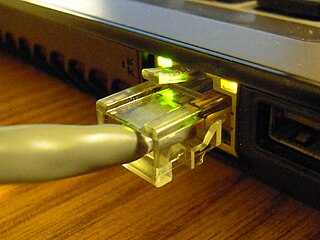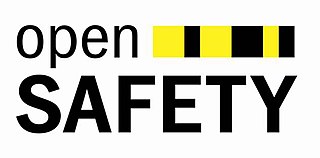
Ethernet is a family of wired computer networking technologies commonly used in local area networks (LAN), metropolitan area networks (MAN) and wide area networks (WAN). It was commercially introduced in 1980 and first standardized in 1983 as IEEE 802.3. Ethernet has since been refined to support higher bit rates, a greater number of nodes, and longer link distances, but retains much backward compatibility. Over time, Ethernet has largely replaced competing wired LAN technologies such as Token Ring, FDDI and ARCNET.
A distributed control system (DCS) is a computerized control system for a process or plant usually with many control loops, in which autonomous controllers are distributed throughout the system, but there is no central operator supervisory control. This is in contrast to systems that use centralized controllers; either discrete controllers located at a central control room or within a central computer. The DCS concept increases reliability and reduces installation costs by localizing control functions near the process plant, with remote monitoring and supervision.

Profibus is a standard for fieldbus communication in automation technology and was first promoted in 1989 by BMBF and then used by Siemens. It should not be confused with the Profinet standard for Industrial Ethernet. Profibus is openly published as type 3 of IEC 61158/61784-1.
A fieldbus is a member of a family of industrial digital communication networks used for real-time distributed control. Fieldbus profiles are standardized by the International Electrotechnical Commission (IEC) as IEC 61784/61158.

Industrial Ethernet (IE) is the use of Ethernet in an industrial environment with protocols that provide determinism and real-time control. Protocols for industrial Ethernet include EtherCAT, EtherNet/IP, PROFINET, POWERLINK, SERCOS III, CC-Link IE, and Modbus TCP. Many industrial Ethernet protocols use a modified media access control (MAC) layer to provide low latency and determinism. Some microprocessors provide industrial Ethernet support.
Fieldbus Foundation was an organization dedicated to a single international, interoperable fieldbus standard. It was established in September 1994 by a merger of WorldFIP North America and the Interoperable Systems Project (ISP). Fieldbus Foundation was a not-for-profit trade consortium that consisted of more than 350 of the world's suppliers and end users of process control and manufacturing automation products. Working together those companies made contributions to the IEC/ISA/FDI and other fieldbus standards development.
Foundation Fieldbus is an all-digital, serial, two-way communications system that serves as the base-level network in a plant or factory automation environment. It is an open architecture, developed and administered by FieldComm Group.

Profinet is an industry technical standard for data communication over Industrial Ethernet, designed for collecting data from, and controlling equipment in industrial systems, with a particular strength in delivering data under tight time constraints. The standard is maintained and supported by Profibus and Profinet International, an umbrella organization headquartered in Karlsruhe, Germany.
EtherCAT is an Ethernet-based fieldbus system developed by Beckhoff Automation. The protocol is standardized in IEC 61158 and is suitable for both hard and soft real-time computing requirements in automation technology.
In the field of Industrial Control Systems, the interfacing of various control components must provide means to coordinate the signals and commands sent between control modules. While tight coordination is desirable for discrete inputs and outputs, it is especially important in motion controls, where directing the movement of individual axes of motion must be precisely coordinated so that the motion of the entire system follows a desired path. Types of equipment requiring such coordination include metal cutting machine tools, metal forming equipment, assembly machinery, packaging machinery, robotics, printing machinery and material handling equipment. The Sercos interface is a globally standardized open digital interface for the communication between industrial controls, motion devices (drives) and input output devices (I/O). Sercos I and II are standardized in IEC 61491 and EN 61491. Sercos III is specified in standards IEC 61800-7; IEC 61784-1, -2, -3 and IEC 61158. Sercos is designed to provide hard real-time, high performance communications between industrial motion controls and digital servo drives.
Foundation Fieldbus H1 is one of the FOUNDATION fieldbus protocol versions. Foundation H1 (31.25 kbit/s) is a bi-directional communications protocol used for communications among field devices and to the control system. It utilizes either twisted pair, or fiber media to communicate between multiple nodes (devices) and the controller. The controller requires only one communication point to communicate with up to 32 nodes, this is a significant improvement over the standard 4–20 mA communication method which requires a separate connection point for each communication device on the controller system.
Sercos III is the third generation of the Sercos interface, a standardized open digital interface for the communication between industrial controls, motion devices, input/output devices (I/O), and Ethernet nodes, such as PCs. Sercos III applies the hard real-time features of the Sercos interface to Ethernet. It is based upon and conforms to the Ethernet standard. Work began on Sercos III in 2003, with vendors releasing first products supporting it in 2005.
Networking cable is a piece of networking hardware used to connect one network device to other network devices or to connect two or more computers to share devices such as printers or scanners. Different types of network cables, such as coaxial cable, optical fiber cable, and twisted pair cables, are used depending on the network's topology, protocol, and size. The devices can be separated by a few meters or nearly unlimited distances.
High-availability Seamless Redundancy (HSR) is a network protocol for Ethernet that provides seamless failover against failure of any single network component. PRP and HSR are independent of the application-protocol and can be used by most Industrial Ethernet protocols in the IEC 61784 suite. HSR does not cover the failure of end nodes, but redundant nodes can be connected via HSR.
Parallel Redundancy Protocol (PRP) is a network protocol standard for Ethernet that provides seamless failover against failure of any network component. This redundancy is invisible to the application.

openSAFETY is a communications protocol used to transmit information that is crucial for the safe operation of machinery in manufacturing lines, process plants, or similar industrial environments. Such information may be e.g. an alert signal triggered when someone or something has breached a light curtain on a factory floor. While traditional safety solutions rely on dedicated communication lines connecting machinery and control systems via special relays, openSAFETY does not need any extra cables reserved for safety-related information. It is a bus-based protocol that allows for passing on safety data over existing Industrial Ethernet connections between end devices and higher-level automation systems – connections principally established and used for regular monitoring and control purposes. Unlike other bus-based safety protocols that are suitable for use only with a single or a few specific Industrial Ethernet implementations and are incompatible with other systems, openSAFETY works with a wide range of different Industrial Ethernet variants.
The train communication network (TCN) is a hierarchical combination of two fieldbus for data transmission within trains. It consists of the Multifunction Vehicle Bus (MVB) inside each vehicle and of the Wire Train Bus (WTB) to connect the different vehicles. The TCN components have been standardized in IEC 61375.

Media Redundancy Protocol (MRP) is a data network protocol standardized by the International Electrotechnical Commission as IEC 62439-2. It allows rings of Ethernet switches to overcome any single failure with recovery time much faster than achievable with Spanning Tree Protocol. It is suitable to most industrial Ethernet applications.
IO-Link is a short distance, bi-directional, digital, point-to-point, wired, industrial communications networking standard used for connecting digital sensors and actuators to either a type of industrial fieldbus or a type of industrial Ethernet. Its objective is to provide a technological platform that enables the development and use of sensors and actuators that can produce and consume enriched sets of data that in turn can be used for economically optimizing industrial automated processes and operations. The technology standard is managed by the industry association Profibus and Profinet International.














